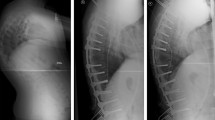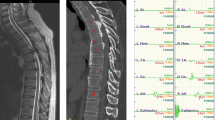Abstract
Preoperative somatosensory evoked potentials (preSEPs) are used to evaluate the severity of myelopathy, and intraoperative neurophysiological monitoring (IONM) is used to reduce iatrogenic damage during operations. However, the correlation between preSEPs and IONM on postoperative neurologic deterioration (PND) in ossification of the posterior longitudinal ligament (OPLL) has not been studied. Thus, under the hypothesis that the patients with deteriorated preSEPs would be more likely to have significant changes in intraoperative SEPs (ioSEPs), and that this would be correlated with PND, we investigated the prognostic value of preSEPs on IONM and PND. This retrospective study included 265 patients who underwent preSEPs and IONM between January 2015 and July 2019. Muscle strength, the sensory scale of the Japanese Orthopaedic Association score examined within 3 days preoperatively, and at 48 h and 4 weeks postoperatively, was analysed. PreSEPs and intraoperative SEPs (ioSEPs) were recorded by stimulating the median and tibial nerves. Intraoperative motor evoked potentials (ioMEPs) were elicited by transcranial electrical stimulation over the motor cortex. PreSEPs latency prolongation of the median and tibial nerves showed significant correlations with ioSEPs. PMD at 48 h or 4 weeks after surgery correlated with ioSEPs and ioMEPs amplitudes. Postoperative sensory deterioration (PSD) at 48 h or 4 weeks after surgery correlated with latency prolongation of ioSEPs. There was a positive correlation between amount of blood loss and maximum percentage of ioSEPs latency prolongation and a negative correlation with PMD at 48 h and 4 weeks postoperatively. PreSEPs predict significant changes in ioSEPs. Furthermore, bleeding control is important to reduce PMD in OPLL.


Similar content being viewed by others
Data availability
Data are not available according to the guidline of our Institutional Review Board.
References
Cerecedo-Lopez CD, Tafel I, Lak AM, Chi J, Lu Y, Groff M, Zaidi HA. Surgical management of ossification of the posterior longitudinal ligament in the cervical spine. J Clin Neurosci. 2019. https://doi.org/10.1016/j.jocn.2019.12.015.
Matsunaga S, Sakou T. Ossification of the posterior longitudinal ligament of the cervical spine: etiology and natural history. Spine (Phila Pa 1976). 2012;37(5):E309–14. https://doi.org/10.1097/BRS.0b013e318241ad33.
Bednarik J, Kadanka Z, Vohanka S, Stejskal L, Vlach O, Schroder R. The value of somatosensory- and motor-evoked potentials in predicting and monitoring the effect of therapy in spondylotic cervical myelopathy. Prospective randomized study. Spine (Phila Pa 1976). 1999;24(15):1593–8. https://doi.org/10.1097/00007632-199908010-00014.
Chiappa KH. Short-latency somatosensory evoked potentials: methodology. In: Chiappa KH, editor. Evoked potentials in clinical medicine. 3rd ed. Philadelphia: Lippincott Williams & Wilkins; 1997. p. 283–340.
Klem GH, Lüders HO, Jasper H, Elger C. The ten-twenty electrode system of the International Federation. Electroencephalogr Clin Neurophysiol. 1999;52(3):3–6.
Krammer MJ, Wolf S, Schul DB, Gerstner W, Lumenta CB. Significance of intraoperative motor function monitoring using transcranial electrical motor evoked potentials (MEP) in patients with spinal and cranial lesions near the motor pathways. Br J Neurosurg. 2009;23(1):48–55. https://doi.org/10.1080/02688690802563349.
Cruccu G, Aminoff MJ, Curio G, Guerit JM, Kakigi R, Mauguiere F, Rossini PM, Treede RD, Garcia-Larrea L. Recommendations for the clinical use of somatosensory-evoked potentials. Clin Neurophysiol. 2008;119(8):1705–19. https://doi.org/10.1016/j.clinph.2008.03.016.
Berthier E, Tuijman F, Mauguiere F. Diagnostic utility of somatosensory evoked potentials (SEPs) in presurgical assessment of cervical spondylotic myelopathy. Clin Neurophysiol. 1996;26(5):300–10.
Kikuchi Y, Baba H, Kawahara N, Nagata S, Tomita K, Nomura S, Yugami H. Experience of diagnosis of thoracic myelopathy using spinal cord evoked potentials. Spinal Cord Monitoring and Electrodiagnosis. Berlin: Springer; 1991. p. 461–71.
Hu Y, Ding Y, Ruan D, Wong YW, Cheung KM, Luk KD. Prognostic value of somatosensory-evoked potentials in the surgical management of cervical spondylotic myelopathy. Spine. 2008;33(10):E305–10.
Restuccia D, Di Lazzaro V, Valeriani M, Aulisa L, Galli M, Tonali P, Maugière F. The role of upper limb somatosensory evoked potentials in the management of cervical spondylotic myelopathy: preliminary data. Electroencephalogr Clin Neurophysiol/Evoked Potentials Sect. 1994;92(6):502–9.
Wang S, Tian Y, Lin X, Ren Z, Zhao Y, Zhai J, Zhang X, Zhao Y, Dong Y, Zhao C. Comparison of intraoperative neurophysiologic monitoring outcomes between cervical and thoracic spine surgery. Eur Spine J. 2017;26(9):2404–9.
Mayer M, Meier O, Auffarth A, Koller H. Cervical laminectomy and instrumented lateral mass fusion: techniques, pearls and pitfalls. Eur Spine J. 2015;24(2):168–85.
Yoon S, Park T, Eun N, Park Y. The cutoff value of ossification of posterior longitudinal ligament (OPLL) for early diagnosis of myelopathy using somatosensory evoked potential in cervical OPLL patients. Spinal Cord. 2017;55(6):606–11.
Smith ZA, Buchanan CC, Raphael D, Khoo LT. Ossification of the posterior longitudinal ligament: pathogenesis, management, and current surgical approaches: a review. Neurosurg Focus. 2011;30(3):E10.
Kale S, Mahapatra A. The role of somatosensory evoked potentials in spinal dysraphism–do they have a prognostic significance? Child’s Nervous Syst. 1998;14(7):328–31.
Kang H, Gwak HS, Shin SH, Woo MK, Jeong IH, Yoo H, Kwon JW, Lee SH. Monitoring rate and predictability of intraoperative monitoring in patients with intradural extramedullary and epidural metastatic spinal tumors. Spinal Cord. 2017;55(10):906–10. https://doi.org/10.1038/sc.2017.43.
Kelleher MO, Tan G, Sarjeant R, Fehlings MG. Predictive value of intraoperative neurophysiological monitoring during cervical spine surgery: a prospective analysis of 1055 consecutive patients. J Neurosurg Spine. 2008;8(3):215–21.
Weinzierl M, Reinacher P, Gilsbach J, Rohde V. Combined motor and somatosensory evoked potentials for intraoperative monitoring: intra-and postoperative data in a series of 69 operations. Neurosurg Rev. 2007;30(2):109–16.
Ghadirpour R, Nasi D, Iaccarino C, Giraldi D, Sabadini R, Motti L, Sala F, Servadei F. Intraoperative neurophysiological monitoring for intradural extramedullary tumors: why not? Clin Neurol Neurosurg. 2015;130:140–9.
Hyun SJ, Rhim S, Kang J, Hong S, Park B. Combined motor-and somatosensory-evoked potential monitoring for spine and spinal cord surgery: correlation of clinical and neurophysiological data in 85 consecutive procedures. Spinal Cord. 2009;47(8):616–22.
Pelosi L, Lamb J, Grevitt M, Mehdian S, Webb J, Blumhardt L. Combined monitoring of motor and somatosensory evoked potentials in orthopaedic spinal surgery. Clin Neurophysiol. 2002;113(7):1082–91.
Pastorelli F, Di Silvestre M, Plasmati R, Michelucci R, Greggi T, Morigi A, Bacchin M, Bonarelli S, Cioni A, Vommaro F. The prevention of neural complications in the surgical treatment of scoliosis: the role of the neurophysiological intraoperative monitoring. Eur Spine J. 2011;20(1):105–14.
Park T, Park J, Park YG, Lee J. Intraoperative neurophysiological monitoring for spinal cord tumor surgery: comparison of motor and somatosensory evoked potentials according to tumor types. Ann Rehabil Med. 2017;41(4):610–20. https://doi.org/10.5535/arm.2017.41.4.610.
Hitchon PW, Dyste GN, Osenbach RK, Jensen AE. Response of spinal cord blood flow and motor and sensory evoked potentials to aortic ligation. Surg Neurol. 1990;34(5):279–85. https://doi.org/10.1016/0090-3019(90)90002-7.
Elmore JR, Gloviczki P, Harper CM, Pairolero PC, Murray MJ, Bourchier RG, Bower TC, Daube JR. Failure of motor evoked potentials to predict neurologic outcome in experimental thoracic aortic occlusion. J Vasc Surg. 1991;14(2):131–9. https://doi.org/10.1067/mva.1991.29237.
Nukada H, Dyck PJ. Acute ischemia causes axonal stasis, swelling, attenuation, and secondary demyelination. Ann Neurol. 1987;22(3):311–8.
Acknowledgements
We would like to thank Department of Biostatstics, college of medicine, the Gangnam Severance Hospital of Korea for help with the statistical analysis, and Editage (www.editage.co.kr) for English language editing.
Funding
There was no funding or support in this study.
Author information
Authors and Affiliations
Corresponding author
Ethics declarations
Conflict of interest
None of the authors have potential conflicts of interest to be disclosed.
Ethical approval
All procedures in this study were in accordance with the ethical standards of the Institutional Review Board of Gangnam Severance Hospital with the 1964 Helsinki declaration and its later amendments or comparable ethical standards.
Informed consent
Informed consent was waived, because it was retrospective study and does not expose patient-identifiable information.
Additional information
Publisher's Note
Springer Nature remains neutral with regard to jurisdictional claims in published maps and institutional affiliations.
Rights and permissions
About this article
Cite this article
Yoo, M., Park, Y.G., Cho, Y.E. et al. Intraoperative evoked potentials in patients with ossification of posterior longitudinal ligament. J Clin Monit Comput 36, 247–258 (2022). https://doi.org/10.1007/s10877-020-00646-0
Received:
Accepted:
Published:
Issue Date:
DOI: https://doi.org/10.1007/s10877-020-00646-0




